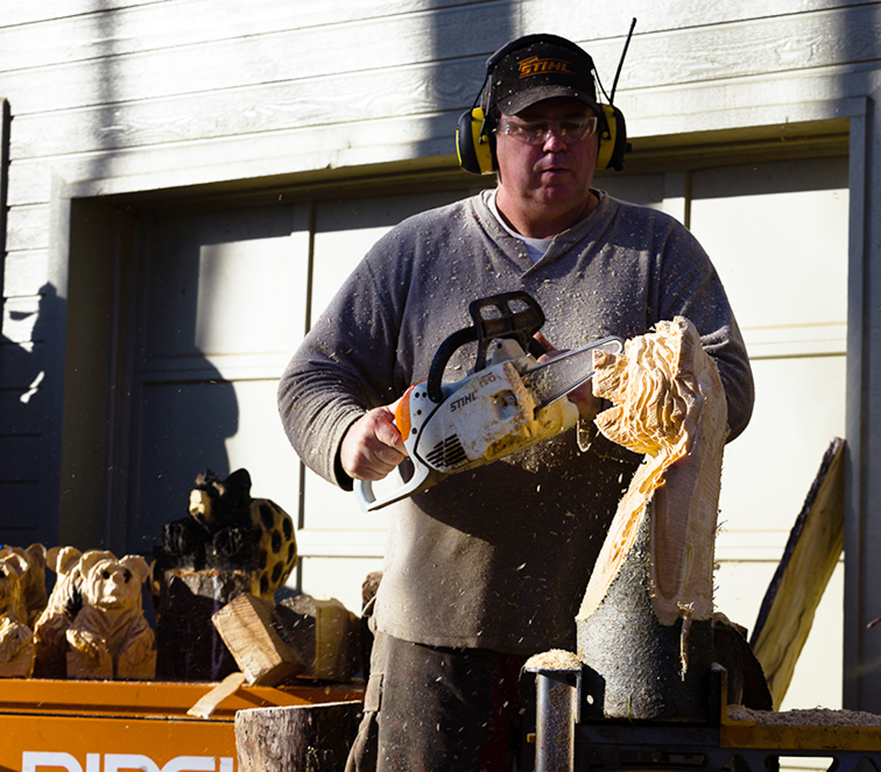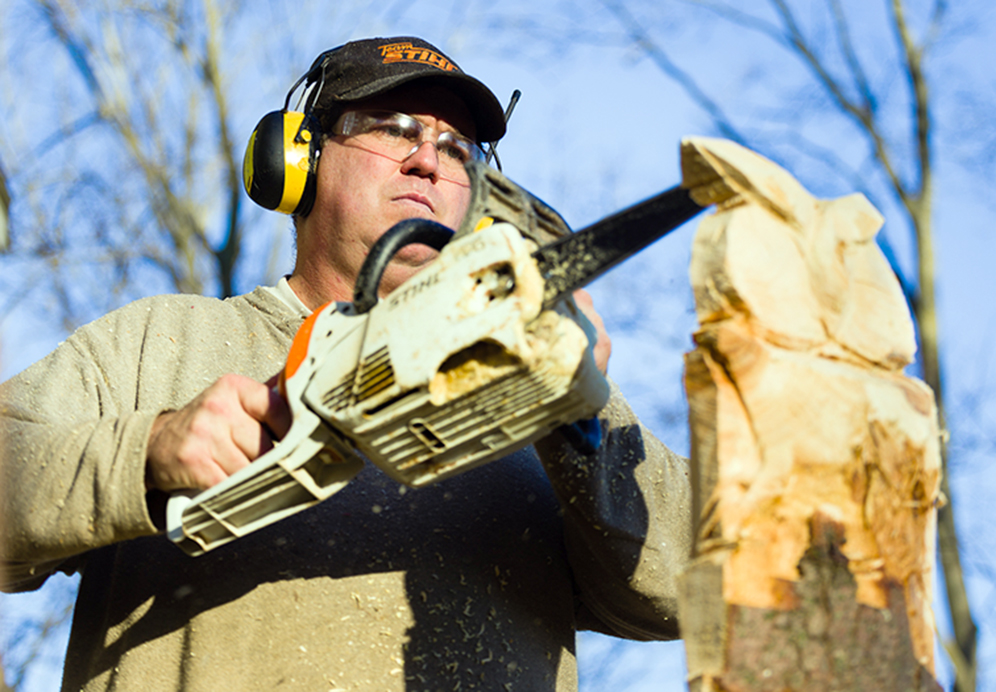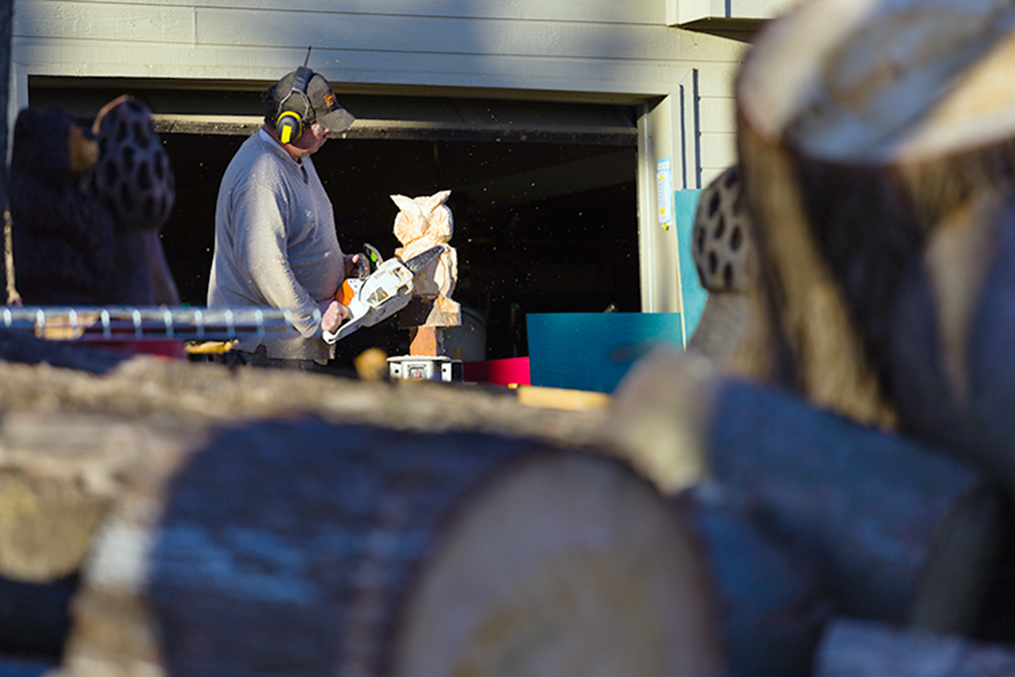 There are 90 and counting wooden bear heads spread around Platte County. The colorful designs of each work are as unique as each story of how they got there.
There are 90 and counting wooden bear heads spread around Platte County. The colorful designs of each work are as unique as each story of how they got there.
TJ Jenkins, a resident of rural Platte County known for his chainsaw art, fastens the painted bear heads to stout trees trunks where they are visible from public roads, a way to display his unique wood carvings. He does more than just the bear heads, recently adding a full-sized replica canoe to his catalog, like the one Meriwether Lewis, William Clark and the Corps of Discovery who paddled down the Missouri River in 1803 used.
Jenkins doesn’t have any formal training, just a love of art. Don’t call him an artist, but he’s found ways to stay cost efficient while trying to sell some of his works to fund his pursuits.
“Lately, it has turned into a little bit of a job,” Jenkins said of his desire to make chainsaw carving a full time profession.
Folk art in Platte County
Bear head 68 is lime green with a purple muzzle. Lime green polka dots bubble to the tip of the purple muzzle like fizz ascending in a newly poured soda. Purple polka dots invade the lime green bear face as colorful lichens growing on a sagging tree.
Bear head 68, like all of his kin, roughly cut from logs, shows a limp red tongue.
Bear head 66 has rough yellow-orange fur, and complimenting blue muzzle and ears.
Red brown polka dots decorate its face adding a touch of Appalachian folk art when viewed up close and give it an appearance of color depth from a distance as seen from a moving vehicle.
Green foliage hides some of the bear heads in spring and summer until fall and winter when they appear, found again, like nests of native raptors clinging to the upper reaches of cold naked trees.
Sunbathing knee high logs, leaning waist high logs and sleeping shoulder high logs, wait their turn for chainsaw carving in Jenkins’ yard. Chunky first edition bears, test carvings of morel mushrooms and an oversized wood pineapple with cartoon caricature spiked crown show where TJ started in his carving to its current state.
Jenkins starts up his white Ford F-250. The guttural growl of the engine, the inefficient weight of the door, the bench seat covered in wood carving tools and a light sprinkle of saw dust gives away the era of the truck.
Jenkins turns the steering wheel hand over hand as if he were drawing up a bucket full of water from a deep well. The wide and shallow turn wanders into the oncoming lane, but there is no traffic and no exacting lines along the country road to make it clear where one lane ends and another begins.
“There was one here, but it got stolen,” Jenkins says as he points through the passenger window. “It had a David Lee Roth kind of face paint.”
Jenkins grew up in St. Joseph, Mo., and graduated from Northwest Missouri State University in Maryville, Mo. His career in TV production and a love for outdoor work took him around the country where he began to admire folk art, much of it on display from the road side and on hiking trails.
“You can go drive the hills of the Appalachians and see all kinds of stuff,” Jenkins recalled, “from pottery art to a guy would take off metal roofs and make these things called blow oscars and whirly gigs.”
The truck leans through a turn. Jenkins points through the front windshield: “There is one in that tree right there. There’s a white one. It’s an early one.”
Care for his mother living in Platte County called him back home. Going for hikes to relieve stress, Jenkins noticed the lack of road side and trail side folk art he had sought in the Appalachians.
“This one’s Phil-Bob. It’s called Phil-Bob,” Jenkins said.
The old Ford slows, but doesn’t quite stop at a country road stop sign.
“That’s what the son and dad named it,” he adds.
With a claw hammer and a flat chisel, Jenkins went to work on his first attempts at folk art as stress relief.
“It was just horrible. But I liked it because it served its purpose. I ended up doing another one and another,” Jenkins said of his early work. “I was able to sell what I carved, which was pretty crazy, I thought at the time. Every single cent I put back into the tools.”
From claw hammer and chisel, Jenkins moved to a modified angle grinder to essentially sand out faces, and finally saved enough to move into chainsaw carving.
“There’s a blue and gold one back there” Jenkins says as he points through the glass of the back window. “Right there; it gets covered over.”
Bears are a staple of chainsaw carvers, but on his emerging artist’s budget, Jenkins could not buy logs large enough to practice at full scale.
So, with the tools he could narrowly afford, he practiced making bear heads. This gave him an affordable, repeatable subject for practice and gave him a stock of heads he could paint and display around Platte County.
“I still do the bear heads on the trees because it kinda reminds me of where I started and of the Appalachians where I lived for a while,” Jenkins said.
The truck immediately slows as Jenkins takes his foot off the gas.
“There’s three on this corner up here. First one’s on the tree on the left. The third one is on the tree in front of us. And the second one is hard to find” he said. “Oh, there it is.”
Most of the bear heads are bolted to trees within Platte County. By keeping the heads within a defined geographic area, people can know to look for them as they drive along the highway and country roads.
The website Jenkins runs, bearheadroad.com, tells the story of some of his bears, but he has not divulged the locations of his folk art with a map, address or directions. Knowledge of a bear head is meant to travel from person to person, as a secret between friends, or a token of knowledge to give a trusted person.
“The woman that let me put it on this tree moved away,” Jenkins said as the white Ford rounds a bend in an arc slightly wider than the radius of the road. “I went to talk to the new owners, and they love it, so it stayed.”
A Platte Woods, Mo. family called the police when their bear head went missing. The bear head came back as silently as it left.
“There’s one on this tree. It’s an early one,” Jenkins said as he points through the driver’s window. “You can tell because when I cut the back it faces too far down.”
Screws cost three dollars. It takes three screws to securely fasten a bear head to a tree. Jenkins asks for “oops paint” from paint stores, incorrectly mixed colors or extra paint when the mixture amount went over the order, to bring down the cost.
Putting more bear heads up around Platte County depends on money coming in from the sales of Jenkins chainsaw carvings. His goal is to fasten 120 bear heads on trees before the coming summer is over.
“Everyone has been so warm to it,” Jenkins said of the response of people when he knocks at their door to ask permission to hang a bear head.
Chainsaw Artist
If Jenkins could have his way, he would use his three years of experience to carve giant teeth, oversized popcorn, his own design of winged hearts, a wall hanging of underwear for a laugh.
But bears are easy to sell. So are morels. One carving pays for the next.
“When you start taking exact orders, it takes the fun out of it for me. It puts a lot of stress into it because you have to match their expectations,” Jenkins said.
Jenkins frowns at the lack of crossover between ingenuity and sales.
“You have to do the stuff that everybody else wants. It’s a lot of repetitive stuff,” Jenkins said. “Every carver, if you look at their face book page, does bears, owls, eagles — every single one of ’em.”
Around the country, bears lean on welcome signs, point to the restaurant entrance and wave goodbye in the rear view mirror.
Jenkins is a reluctant salesman.
“I’m still getting used to the fact that people will buy my stuff,” he said. “I’ve been doing it three years and getting comfortable with it now.”
Jenkins is also reticent to call himself an artist, parrying the term several times in conversation.
“I was never formally trained,” he explained. “I didn’t go to another carver and apprentice under somebody.”
The majority of his sales happen during paid demonstrations. Jenkins loads the bed of his white Ford with finished pieces bearing price tags, uncut logs shaken from sleep, three chainsaws and a supply of gas and oil for festivals, fairs and grand openings.
“Every carver that’s been carving for four, five, six years has a very specific looking bear.” Pointing to a bear with deep-set power carved eyes he said, “I’m starting to get a bear that people can recognize as my bear.”
In 2003, the Missouri Department of Conservation carved out two canoes from cotton wood tree trunks using the original method, employing drawknives, cooper’s adz and foot adz. The anticipation of the bicentennial converted a group of enthusiastic re-enactors to consider the possibilities of making the same waterborne voyage as the land surveying explorers.
After paddling the pair of dugout canoes from Franklin Island to Jefferson City, Mo. one took up residence in the Anita B. Gorman Discovery Center. Thousands of school children and visitors have memories of miming paddling movements and lining up by height in and around the 30-foot canoe for a group photograph.
A decade of rain, snow, children’s play and the microscopic ravages of rot slowly broke down the unexpectedly popular attraction.
Missouri Department of Conservation education specialist Pat Whalen, who took part in the 2003 re-enactment, suggested replacing the canoe.
“First they said, where you going to get a tree?” Whalen said of the reaction of the Discovery Center staff. “I said, ‘Are you kidding? Who owns more trees in Missouri? We got a tree somewhere on MDC property.’ They said, ‘If you get the tree, we’ll figure it out.’”
The Discovery Center agreed on Jenkins as a local artist to replace the 30-foot canoe, this time carved with modern tools, though little less easy on the back and patience to shape and hollow a two-ton cotton wood trunk.
“It was a labor of love because, I am pretty sure if he had to do it over again, it was way more work than he ever thought,” Whalen assessed, standing at the head of the canoe. “And again, it’s kind of a big hit with the kids.”
Don’t Try This in Your Backyard
To keep down the cost of his artwork, Jenkins learned how to repair his chainsaws. The repair shop returns the delicate oil system to working order, but it was a mystery to Jenkins what they were doing to fix the ferocious but sensitive machines.
Curiosity led him to open them up on his own and tinker until he understood the nature of their health — the growling beat of their heart, their dark pulmonary system, the fast twitch of their muscle.
“Like a standard chainsaw, you can feel every tooth hit when you’re working on detail,” Jenkins said. “So there are things you can do to change that and make it cut like a butter knife.”
Jenkins points to the guard link on the saw chain he has meticulously filed down on his three chain saws. Each saw has a different bar length and shape for carving: long and round for rough cutting, short and pointed for detail carving.
“Carvers like the nose, ’cause that’s where you detail,” Jenkins said. “Then you got to know where on the nose you can go and where you absolutely can’t,” Jenkins explains as he points to safe and unsafe angles on the tip of the bar.
Jenkins demonstrates, pivoting the motor of a chainsaw around his front handle wrist to show how kickback on a long cutting blade is out of control of any carver’s strength. The tip of the oiled bar makes an easy arc to bisect his face, an eye visible on each side of the black and silver saw chain.
“There are a lot of mistakes made, and mistakes usually hurt,” Jenkins says.
With a quick jerk of the pull handle, Jenkins’ STIHL, orange and white underneath a thin layer of fine sawdust and oil, wakes up hungry. A practiced set of cuts removes a large diagonal hunk of wood, a waste the size of the carving piece.
Wait. Not waste. Just yin and yang separated; two carvings from one log.
More practiced cuts. Down stroke, down stroke. Jenkins steps through the spreading layer of sawdust; long wooden noodles that dive with urgency and a mist of fine slivers weighted by the scented moisture of the wood fall with gravity.
Down stroke, down stroke.
Jenkins stops the saw, sets it on a bench. The abrupt silence echoes between the chambers of the inner ear and safety ear muffs. Carpenter pencil in hand, he sketches geometric notes.
A short pull on another chainsaw from the bench. Side stroke, side stroke. Jenkins ponders momentarily, looks at the carved log from another angle.
With the underside of the bar tip he cuts curves, grooves, carves out pits, channels, waves — everything that makes chainsaw carving dangerous.
The log is no longer a log, or a cut log, nor a shaped log.
It’s a bear head.
The chainsaw stops.
Jenkins shakes the smallest chainsaw from sleep. Curiously stubbed nosed, the bar — a short triangle that looks like it came from a scale model of a chainsaw — gently touches the fine details of the face.
Cutting gently into the bear head, removing the final excesses, causes it to grow soft hair on its muzzle and shaggy chest hair under its chin. Small strokes enliven a listening pair of ears, furrow a brow and place curiosity in the eyes.
In a birthday candle puff, Jenkins removes the last resting saw dust; the number 89 in relief.






